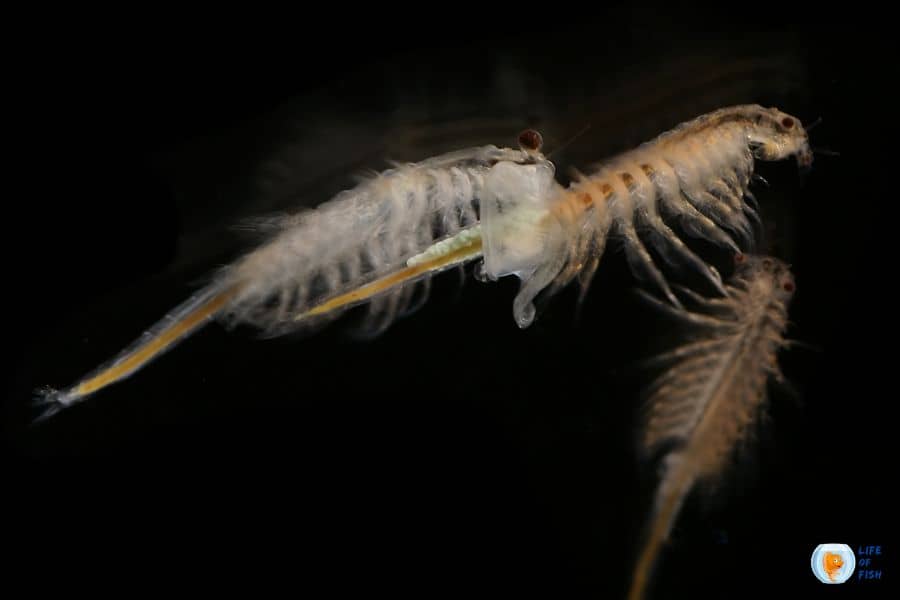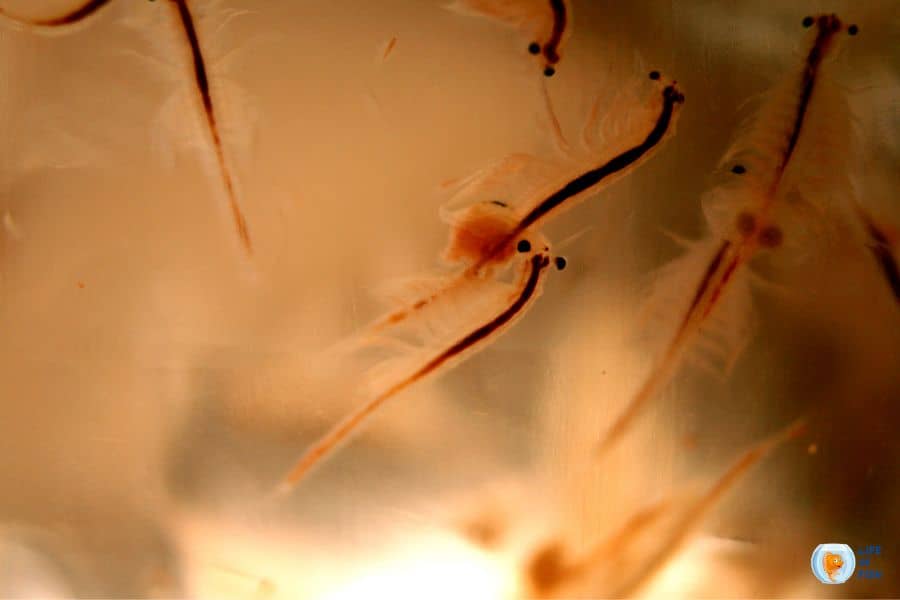Brine shrimp habitat can vary due to many reasons. They can be found in all types of ocean habitats, from near-shore reefs to deep-sea hydrothermal vents. Brine shrimp are one of the most abundant and diverse marine invertebrates. While they may seem like simple crustaceans, brine shrimp possess a wide variety of physical and behavioral adaptations that allow them to thrive in extreme environments.

Brine shrimp habitat: Where do brine shrimp live in the wild?
Jump To
Brine shrimp are tiny, filter-feeding crustaceans found in tropical saltwater pools, salt marshes, and oceans throughout the world. They are found in the natural salt lakes of Utah, California, and New Mexico. They are one of the very few creatures to flourish in the Great Salt Lake. Brine shrimp are very important to the ecology of the lake, serving as a major source of food for migratory birds
Can brine shrimp live in saltwater?
As the name suggests they are saltwater creatures. They are often found in saltwater ponds and marshes and they cannot live in freshwater systems very long. They usually live in the water of very high salinity (25 parts per thousand) and therefore, they could avoid most types of predators. The optimum for Artemia is 100 to 150 parts per thousand. They have special features to adopt for the high salt concentrations.
Brine shrimp’s circulatory and respiratory systems work together to remove extra salt from their body and distribute oxygen. Brine shrimp have a protein called hemoglobin in their blood. This helps the oxygen to be more efficiently transported to cells around the body. They need hemoglobin because oxygen levels can be very low in salty water. Then, the gills pump the excess salt, water, and carbon dioxide out of the body. Additional salt is pumped out through exocrine glands.
Can brine shrimp live in freshwater?
As their name suggests, they are saltwater creatures and cannot live longer in freshwater. Brine shrimp survive in fresh water for 30 minutes or longer, but unless you overfeed, the fish snap them up long before then.
What conditions do brine shrimp live in?
The Brine shrimp life cycle begins with the hatching of dormant cysts. They are encased embryos that are metabolically inactive. The cysts can remain dormant for many years as long as they are kept dry. When the cysts are placed in salt water, they are re-hydrated and resume their development. However, the cysts begin development only if they meet the optimum environmental conditions.
At 25 C (77 F) the cysts burst and the embryo leaves the shell. It takes 15 to 20 hours to leave the cysts from the moment they are put in the water. The embryo will grow and progress through 15 molts before reaching adulthood in approximately 8 days. Other variables of importance for the hatching are pH, light, and oxygen. The optimal pH level is 7.5-8.5. You can adjust the pH by adding muriatic acid and baking soda.
For example, if you need to lower the pH value add muriatic acid, and to increase it add baking soda. A minimum amount of light is necessary for hatching and is beneficial for increased adult growth.

What do brine shrimp need to survive?
Once the baby brine shrimp get out of their eggs, you need to provide them below conditions to survive.
A Growing-out Tank
Disinfect the tank before stocking to limit the number of bacteria present in the tank.
Salinity
The preferred salinity range for culturing brine shrimp is 35-40 ppt (specific gravity 1.024-1.028. However, brine shrimp are euryhaline animals and they are tolerant of a wide range of salinity. According to the literature, they can tolerate salinity from 5 ppt. to around 220 ppt. The reason to keep above the salinity range is to reduce the amount of osmotic stress the brine shrimp are subjected to.
The exact salinity is of minor importance, just keep it around this level. You can simply adjust the salinity by adding 35g of salt to 1 liter of water. Make sure that the salinity of the hatching medium is the same as the salinity in your grow-out tank; in this way, the nauplii will not have to bridge a salinity shock.
pH
It is important to resemble the pH level of their natural environment. The pH value of most of the salt lakes and solar evaporation ponds that brine shrimp naturally occur in ranges from 8 to 9. It is the most optimal for brine shrimp. However, the pH value slowly drops during the cultivation due to the release of waste products and subsequent nitrification.
You will have to perform water changes and/or enhance the buffer capacity of the medium. For that, you can use technical grade NaHCO3 (until 2 g per liter). It is advised to use Na2CO3 as this increases pH to above 9!
Temperature
Brine shrimp can tolerate a wide variety of temperatures, however, a temperature ranging from 20°C to 30°C (68 F to 86 F) is the most suitable temperature. It is reported that the optimal temperature is important for reaching the highest reproduction rates. For example, in order to achieve the highest reproduction levels for Artemia franciscana a rearing temperature of around 24° C (75 F) is optimal.
At the lower range (i.e. 20°C and lower) they grow slower, are less active, require less food, achieve higher food conversion rates, and live longer. However, the reproductive period is shorter and the total offspring is much smaller.
Aeration
Moderate aeration should be installed to keep the amount of dissolved oxygen at a level (around 4 to 5 mg O2 per liter). Aeration is also important to keep the administered food suspended throughout the water column. Make sure to air pumps that create small to medium size bubbles as the very small bubbles create problems for their feeding behavior.
These small bubbles may get stuck between the thoracopoda (“legs”) of the brine shrimp seriously hindering food uptake and carrying the brine shrimp to the water surface where they will be helpless! You can identify that they get lower oxygen by their reddened eyes.

Light
Do not provide too much light as this might be counter-productive. A few installed standard light bulbs will be enough. In nature, adult brine shrimp will move to the deeper parts of the ponds during the period with the highest light intensity. In contrast, the nauplii are attracted to light and move toward the light source.
Water Quality
Although brine shrimp are hardy fish in terms of water quality, baby brine shrimp are much more sensitive to poor water quality as compared to adult brine shrimp. Therefore high levels of ammonia and nitrites should be avoided. Controlling water quality can be accomplished through a combination of biological filtration, frequent water changes, and siphoning out of dirt settling on the bottom.
Feeding
If you keep the culture for several days, feed the brine shrimp. A solution of baker’s yeast and fish tank water to form a milky solution is an ideal food for the growing brine shrimp. Since overfeeding can foul the culture, keep in mind to feed them with a sufficient meal. . The brine shrimp culture only needs a few drops of the yeast solution as they are not big eaters. You can keep the yeast solution in a dropper bottle and store it in the refrigerator.
The most difficult challenge in culturing artemia is providing appropriately sized feed in sufficient concentrations without unduly compromising water quality. Fortunately, there are a number of easily obtained feeds that are optimal in terms of both size (less than 20 microns) and nutritional content. The preferred feed for artemia is cultured, live diatoms. A number of species have been used successfully, including Nannochloropsis sp., Tetraselmis sp., and Dunaliella sp.
Brine shrimp are continuous feeders and, at high densities, quickly clear water of diatoms. Apart from them, you can use readily available foods such as cryo-preserved algae pastes, spray-dried, single-celled yeasts, micronized forms of rice bran, corn bran, and soybean. Whatever, you feed make sure you give enough food as it is very important for their survival.
Do brine shrimp live in cold or warm water?
Brine shrimps live in warm water. The ideal water temperature range for Brine Shrimp is between 70 and 80°F (21 to 26.6°C). Brine shrimp are temperature tolerant and can survive in lower temperatures, but in doing so their metabolic rate drops.

Related questions
Do brine shrimp need light to grow?
They don’t need light to grow up. The juvenile brine shrimp like light and in contrast adults don’t like light and they swim away from the light resource.
Do brine shrimp need oxygen?
Brine shrimp are generally tolerant of low dissolved oxygen levels. Salt lakes, their natural environments have low dissolved oxygen concentrations. However, providing aeration is necessary to keep food in suspension and eliminate any dissolved oxygen problems.
Oxygen stress is often indicated by the visible reddening of the animals caused by the increased presence of hemoglobin. If your animals show signs of oxygen stress, add additional air stones. Small bubbles are efficient vehicles for oxygen transfer. However, keep in mind not to use very fine bubbles as they interfere with the feeding and locomotion of brine shrimp.
Are Sea Monkeys brine shrimp?
Sea monkeys are an artificial breed of brine shrimp. They are a hybrid breed of brine shrimp called Artemia NYOS produced in 1957 by Harold von Braunhut. They got the name “monkeys” as their tails remotely resemble those of monkeys. They’re creatures that spring to life the second magical dust touches water, thus they are called “ instant life “ in the aquatic industry.
When you buy a packet of Sea-Monkeys, they appear to be lifeless dust. This dust is their eggs and just put the dust into the water and you can see Sea Monkeys spring to life. The main difference between the brine shrimp and Sea monkeys is that brine shrimp are naturally occurring species and the other is an artificially bred species.
Sea monkeys were bred specifically to be pets, while brine shrimp are pretty much just fish food. Brine shrimp typically live from 1 to 3 months long, while sea monkeys will live to a ripe old age of about a year, as long as all of the conditions are right. Sea monkeys also tend to be a little bit larger than typical brine shrimp, although this isn’t always the case. But sea monkeys can grow up to an inch long, and brine shrimp tend to stay closer to half that size.
Although Brine shrimp are very fragile, sea monkeys are a little bit harder than their brine shrimp relatives and will be a little bit easier to hatch. Apart from that, they both are saltwater creatures and their food carvings are the same.
Conclusion: Brine shrimp habitat
Brine shrimp are small creatures who live in the saltwater systems of the world. They are popular fish feed in the aquaculture industry. Although they can adapt to changes in oxygen level, temperature, and salinity, there are recommended levels of those parameters. They are available in eggs(cysts) and live brine shrimps in aquariums. However, you can raise them in your aquarium too.
Read Next : How To Keep Brine Shrimp Alive? (It’s Easy)
